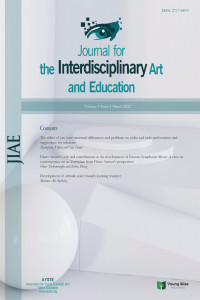Painting education during pandemic process
Painting education during pandemic process
TThe research is of qualitative character and is a case study. Participants are teachers with at least 10 years of seniority who teach online painting training in Izmir. 6 art teachers voluntarily participated in the study. Semi-structured Interview Form was used as data collection tool. The semi-structured interview questions were 10, and 2 were submitted to expert opinions and corrections were made. An example interview question; “Since it is important to exhibit student works, what do you think about the pandemic process of the exhibition reaching its purpose and being efficient? Why is that?". Content analysis technique was used in the analysis of the data, and the themes and sub-themes created as a result of the analysis were presented in the report in tables. As a result of the research; There are opinions stating that they use distance education tools, that they have sufficient and insufficient opinion about the adequacy of the technological tools used, that painting art education can and cannot be done online. They stated that there is an inability to give feedback about the difficulties experienced, the absence of an applied environment, the limited access of every student to technological tools, and interventions may occur from where the student lives in the education. They stated that they overcame the problems with virtual environments with sharing groups. They stated that their students' participation in education was generally high. They made suggestions such as making videos and improving the discipline in order to increase efficiency. They stated that they used whatsapp and uploading to the system. They stated that the students did not participate much in the creation of the online exhibition and they could not get much efficiency. They stated that the applied painting course is mostly taught theoretically through distance education. As a result of the interviews, the online painting lesson is not at a level to meet the expectations, there are deficiencies, there are problems in the application part of the students, although there are theoretical learning while taking online painting lessons, therefore, the online art lesson education cannot replace face-to-face education, There is a common opinion of the majority as it is processed.
___
- Coleman, K and MacDonald, A. (2020) Art education during the COVID-19 lockdown, Teacher, (2 June 2020) ISSN 2208-6463 (2020).
- Faramelli A., Graham J. (2020). From Distant Horizon to the ‘Uncoercive Rearrangement of Desire’: Institutional Pedagogy and Collaborative Learning in an Instance of Arts and Curatorial Education, NSEAD and John Wiley & Sons Ltd, iJADE (2020).
- Lee L. (2020), ‘The Show Must Go Online’: Arts Teachers Adapt to At-Home Instruction, https://www.edutopia.org/article/show-must-go-online-arts-teachers-adapt-home-instruction
- Plagens P. (2020). Remote: Teaching art online, https://www.twocoatsofpaint.com/2020/04/remote-teaching-art-online.html
- Pratama, U.N. & Surahman, E. (2020). Investigating Student Responses of Online Learning during the Covid-19 Pandemic in Performing Art Education. 2020 6th International Conference on Education and Technology (ICET), 64-69.
- Stewart, M. (2006). Elarn magazine, Teaching art at a distance, https://elearnmag.acm.org/archive.cfm?aid=1190072
